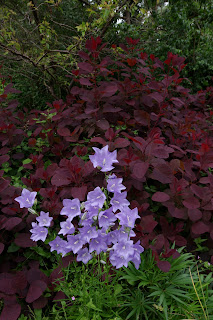Another shot of a Meadow Brown. This one is nectaring on Greater Knapweed in the wildflower patch on the allotment. Two factors are crucial for butterflies. One is the weather during the life cycle of egg/larva/pupil/adult. The other is the availability of their food plants.
I mentioned in Wednesday's entry that the weather we've had may result in a bad year for butterflies. I noted that I saw none at all on a route I walked which is usually terrific for butterflies from June onwards. Emergence will no doubt have been delayed/diminished by the atmospheric conditions. Not only that I was dismayed to see that the length of this stretch has been heavily mowed.
Ordinarily a wonderful selection of wildflowers grows on the verges either side of the path, particularly on the right which is south facing. That has been decimated apart from Stinging Nettles and a few Umbellifers growing out from within the hedgerows.
This track runs between large fields of arable monoculture of negligible benefit to wildlife and sprayed regularly. These hedgerows and the space between are therefore an especially valuable habitat providing both shelter and food for the complete life cycle of a butterfly.
The situation is not entirely hopeless. For example there is a lot of bramble running through the hedges which is about to come into flower. But it would have been so easy just to mow a central strip along the well defined path leaving a foot or two of longer grass and wildflowers at the base of the hedges. This would have balanced the benefits to wildlife with the path being used as an amenity.
I thought countryside management had become a bit more enlightened. Bad weather is what is but bad practice is a double whammy. Moreover fewer butterflies on the wing this year means less caterpillars for next year. I'm sorry to say this particular habitat may take a long time to recover its equilibrium.



























